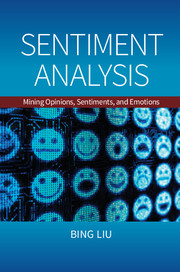Book contents
- Frontmatter
- Contents
- Preface
- Acknowledgments
- 1 Introduction
- 2 The Problem of Sentiment Analysis
- 3 Document Sentiment Classification
- 4 Sentence Subjectivity and Sentiment Classification
- 5 Aspect Sentiment Classification
- 6 Aspect and Entity Extraction
- 7 Sentiment Lexicon Generation
- 8 Analysis of Comparative Opinions
- 9 Opinion Summarization and Search
- 10 Analysis of Debates and Comments
- 11 Mining Intentions
- 12 Detecting Fake or Deceptive Opinions
- 13 Quality of Reviews
- 14 Conclusions
- Appendix
- Bibliography
- Index
2 - The Problem of Sentiment Analysis
Published online by Cambridge University Press: 05 June 2015
- Frontmatter
- Contents
- Preface
- Acknowledgments
- 1 Introduction
- 2 The Problem of Sentiment Analysis
- 3 Document Sentiment Classification
- 4 Sentence Subjectivity and Sentiment Classification
- 5 Aspect Sentiment Classification
- 6 Aspect and Entity Extraction
- 7 Sentiment Lexicon Generation
- 8 Analysis of Comparative Opinions
- 9 Opinion Summarization and Search
- 10 Analysis of Debates and Comments
- 11 Mining Intentions
- 12 Detecting Fake or Deceptive Opinions
- 13 Quality of Reviews
- 14 Conclusions
- Appendix
- Bibliography
- Index
Summary
In this chapter, we define an abstraction of the sentiment analysis problem. This abstraction gives us a statement of the problem and enables us to see a rich set of interrelated subproblems. It is often said that if we cannot structure a problem, we probably do not understand the problem. The objective of the definitions is thus to abstract a structure from the complex and intimidating unstructured natural language text. The structure serves as a common framework to unify various existing research directions and enable researchers to design more robust and accurate solution techniques by exploiting the interrelationships of the subproblems. From a practical application point of view, the definitions let practitioners see what subproblems need to be solved in building a sentiment analysis system, how the subproblems are related, and what output should be produced.
Unlike factual information, sentiment and opinion have an important characteristic, namely, they are subjective. The subjectivity comes from many sources. First of all, different people may have different experiences and thus different opinions. For example, one person bought a camera of a particular brand and had a very good experience with it. She naturally has a positive opinion or sentiment about the camera. However, another person who also bought a camera of the same brand had some issues with it because he might just be unlucky and got a defective unit. He thus has a negative opinion. Second, different people may see the same thing in different ways because everything has two sides. For example, when the price of a stock is falling, one person may feel very sad because he bought the stock when the price was high, but another person may be very happy because it is an opportunity to short sell the stock to make good profits. Furthermore, different people may have different interests and/or different ideologies.
- Type
- Chapter
- Information
- Sentiment AnalysisMining Opinions, Sentiments, and Emotions, pp. 16 - 46Publisher: Cambridge University PressPrint publication year: 2015
- 2
- Cited by



